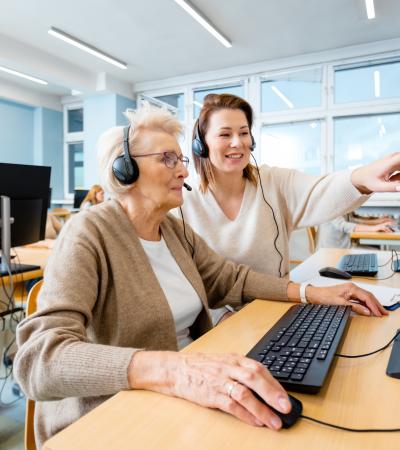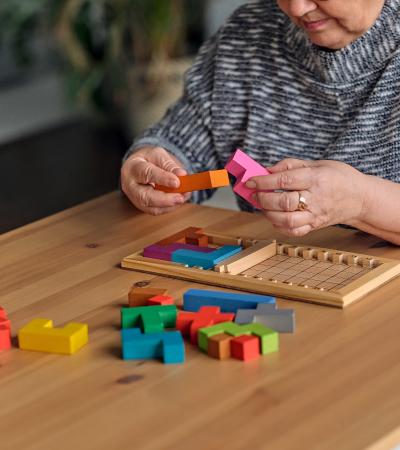The primary goals for the Healthy Living Outreach for Seniors program were to help seniors develop the ability to use technology through tablets, as well as understand the importance of e-health literacy and patient-centered care.
Advanced Planning
The target population for this program was adults 62 years of age or older who resided at Sunnycrest Retirement Village in Sioux Falls. Sunnycrest is an independent senior living facility that has a partnership with Siouxland Libraries, and they were a perfect fit for this program because of their population and staff’s interest in helping their residents build their health information knowledge.
Sunnycrest's activities coordinator, Jean Anderson, helped order the tablets, and we went over how to access the websites we would use. The tablets used were Samsung Galaxy Tab A, with a 9.7-inch screen and wifi capabilities. The larger screen allowed for improved readability. Otterbox Defender cases equipped with kickstands were placed on the tablets for protection. We used Verizon JetPack during the sessions to create a wifi hotspot for up to 15 devices.
A list of websites was left with Jean so she could get the rest of her staff familiar with the reliable sites and help residents when a library staff member was not available. We utilized the following websites: HealthFinder, MedlinePlus, NIH Senior Health, Go4Life, Iowa State University Extension and Outreach Spend Smart Eat Smart, USDA What’s Cooking, Mayo Clinic and Veterans Health Administration.
Marketing
To market this outreach program, Sunnycrest put information on their monthly and daily calendars, both in print and electronically. They have an internal television station where they displayed the information. We consistently went at the same time each month; if a date needed to be changed we gave notification three weeks prior to meet the deadline of the Sunnycrest calendar.
In retrospect, our marketing should have taken a more comprehensive approach to health and well-being rather than just focusing on diseases and disorders.
Day-of-event Activity
Surprisingly, technology was not a barrier even though many of the residents said they were not sure how to use a tablet. Once it was started up and we searched for the term, they were comfortable using it and caught on very quickly with how to maximize the screen, search for terms and scroll through articles.
I believe that having the kickstand on the cases greatly helped, as they were able to be mostly hands-free.
Other residents had their own tablets in their apartments, so many of them practiced using the search boxes or filters on the sites and then, at the end, took a list of recommended sites back with them.
Program Execution
I often arrived about an hour before the program began or the guest speaker arrived. Many of the residents did not want to spend very much time conversing with us before as they wanted to make sure they found a seat. The way our program was designed was a come-as-you-want setting. In hindsight, we should have structured it as a class where certain times were designated to explaining certain tasks.
We used surveys as our evaluation tool. We printed surveys, which were available in a large-sized point and easy to read font. The surveys consisted of questions based on their use and knowledge of the resources available. There was a statistical background section asking questions about where they usually search for information, if they found this information helpful, and if they had made positive lifestyle changes since gathering new information and talking to their doctors. Overall, we had quite positive feedback.
Next, we gauged and evaluated our program by talking with the residents. We had a few people who took notes and wrote down questions to discuss with their doctor. They informed us that their doctors took the time to answer their questions and clarify any points of confusion. Additionally, many of them shared that their doctors were pleased with the initiative shown in their own health outcomes. We also had a few participants who put their new knowledge to use with friends through looking up healthy recipes.
Advice
In the first few visits, many of the residents asked what I would be teaching to them during the hour. This indicated a problem with marketing which could be fixed by restructuring of the class.
For those who want to hold a similar program, we advise you to find a partner retirement organization that will give you access to your target population of older adults. This organization can also help with the logistical planning and marketing of these events. We recommend that you do try to structure each session with a formal schedule rather than leaving it more open. Having a schedule will be mutually beneficial for you and your audience; you can present the most information and they can receive the most information.



